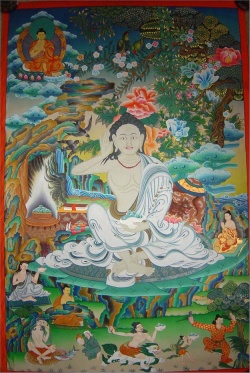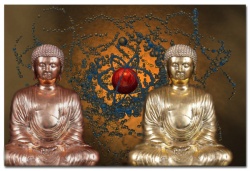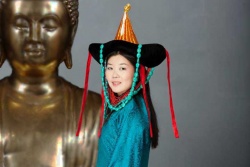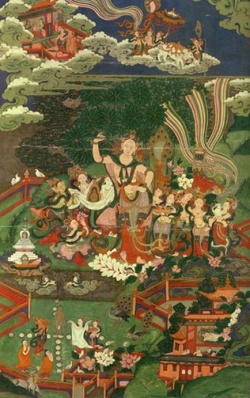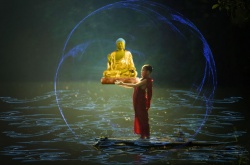The Twelve Links of Interdependent Origination
by Geshe Rabten Rinpoche
Geshe Rabten Rinpoche, one of Sera monastery's most renowned meditation masters, was appointed a spiritual assistant to His Holiness the Dalai Lama in the mid-1960s. Upon the request of His Holiness he began teaching Westerners in Dharamsala in 1969, and went to live and teach in Switzerland in 1975. He passed away at his Swiss center, Rabten Choeling, in 1986. This teaching was given at Tushita on April 11th, 1980.
Edited from an oral translation by Gonsar Rinpoche. From Teachings at Tushita, edited by Nicholas Ribush with Glenn H. Mullin, Mahayana Publications, New Delhi, 1981. A new edition of this book is in preparation. Tushita Mahayana Meditation Centre is the FPMT centre in New Delhi, India.
To practise Dharma is not merely to carry the name of being a buddhist. Nor is it to make certain superficial alterations in our lifestyle. Dharma practice means the total integration of our minds and the Dharma.
For this to become possible we must first prepare ourselves by cultivating spiritual stability-a sense of pure renunciation-within our stream of being. The Tibetan term for this, nges-jung, implies that we should first realize that we are caught in the rebirth process of cyclic existence, or samsara, a state of being characterized by a great many sufferings. Therefore at the beginning of our practice we must realize the true nature of samsara itself and the way in which we exist in samsara.
We must become aware of the unsatisfactory nature of samsara, the condition in which we find ourselves. This is very important. Once we have recognized the true nature of samsara and become disillusioned with it, from the depths of our hearts we should generate a spontaneous aspiration to attain liberation from it. Such a pure and spontaneous aspiration of seeking liberation is the meaning of renunciation.
Generally there are two ways to develop the renounced mind. The first of these involves meditation on the two aspects of samsara: the suffering nature of samsara and the causes of samsaric suffering. The second method of developing renunciation is based upon meditation on the twelve links of interdependent origination (Sanskrit: pratityasamutpada). I would like to speak briefly on this second technique.
There are two main ways of explaining the twelve links:
a scriptural presentation,
which explains the twelve as a general mode of the nature of samsaric evolution, and
an experiential presentation,
which speaks of the twelve links in terms of how they are experienced by an individual over a continuum of lifetimes.
The order of the links differs slightly between these two systems. I would like to focus on the twelve links in the context of how they are experienced.
The first of the twelve is ignorance, the root of all samsaric sufferings. In Sanskrit, this is avidya, which means "not seeing." An obscuration of the mind is implied. To explain precisely what this ignorance is and how it functions would require a great deal of time and energy. Therefore, let's concentrate on the central principles.
People who go to a specific teaching or discourse gather with the intention, "Today I will go and listen to the teachings." We all have certain conceptions about our "selves," about this "I". This conception of "I" is the ego. It is something present in us at all times, becoming more obvious on certain occasions. For example, when you encounter very positive circumstances or, conversely, face a great difficulty, your conception of the "self" becomes more intense and visible than usual. Each of us is subject to our own concept of "I" in this way. We can see this quite easily without lengthy theoretical reasonings. It can become clear in our daily experiences.
When circumstances cause this ego-concept to arise with great strength, we are grasped by it as if the "I" existed within us as something very solid, very vivid, and totally uncontrollable. Such is the way the false self grasps us. However, whether or not the self exists as it appears to the ordinary person is an important subject of contemplation. If we search within ourselves, from the top of our head down to the soles of our feet, we come to the conclusion that normally neither the physical body itself nor any of its individual parts can serve as the "I" which arises so strongly in traumatic experiences.
There is nothing in the body to represent our sense of "I". The bodily organs and so on are only parts of the body. The body sort of "owns" them. If we analyze our minds in the same way, we find that the mind is but a stream of different thoughts and mental factors. This brings us to the conclusion that there is nothing in the mind to actually represent the "I" that we have conceived. Moreover, there does not exist any separate entity outside the body and mind to represent the "I" or self. We should meditate like this and see how it is so.
When we analyze, we don't find anything to stand for "I". This does not mean that we do not exist at all. Complete non-existence cannot be the situation, for we are presently analyzing how we exist. Although we do not find an entity to represent the self when we search the body and mind for one, we find our situation is very subtle. We do not exist as simply as the ignorant mind supposes. To understand the true nature of the self requires thorough training and sustained meditational practice.
This factor of the mind that holds a wrong view of the self, a fabrication of the self, is what is meant in Buddhism by ignorance. It is this ignorance that is the first of the twelve links of interdependent origination. On the foundation of this false concept of the self rest all the other delusions, such as attachment towards ourselves, our friends and possessions, and aversion for things and people foreign or alien to us. The development of these attachments and aversions in turn causes us to accumulate a great number of unwholesome karmas. Unwholesome thoughts lead to unwholesome actions of body and speech.
The distorted actions of body, speech and mind that are produced by ignorance, attachment and hatred stain the mind with what are called volitional formations. This is the second of the twelve links. The moment after we produce a distorted karma, the action itself has passed and is gone, but an imprint has been left on our stream of consciousness. That imprint will remain with the consciousness until it manifests in the future as a favorable or unfavorable experience, depending on the nature of the original action.
The base upon which the imprints of karma are left is the continuity of the stream of mind. Therefore the mind which serves as the basis of the imprints of karma is the third link, the link of consciousness. This stream of consciousness carries the imprints, and later helps them to ripen and manifest. This process may be likened to sowing a seed in the earth, which serves as a cause of the growth of a crop. However, as well as sowing seeds in the ground, favorable conditions are required for the seeds to grow. Contributory causes such as water, fertilizer and so forth must be present in order for the seeds to ripen and reach maturity.
The attachment which evolves from ignorance helps to cultivate the karmic seeds which have been sown in our stream of consciousness.
This attachment is the fourth link.
There also exists in our mindstream a type of attachment which has a special function in bringing karmic seeds to fulfillment.
This is the fifth of the twelve-linked chain.
This particular attachment, which is called craving, manifests at the end of our life and gives an anticipation of our future existence. Although both above types of attachment have the nature of desire, each has its own function. One helps to ripen karmic seeds, whereas the other brings them to completion and connects us with our future existence.
The sixth link is 'becoming.' When we come to the end of our present life, a certain mental karma arises and immediately directs us towards our future existence. This special mental action which appears at the final stage of our life is called 'becoming.
These six links are generally associated with this life, although it is not necessarily the case that they should manifest in this life. In particular situations some of them may develop in other lifetimes, but in most cases they belong to this life.
As we near death our body and mind begin to weaken. Bodily strength and the grosser levels of thought dissolve until finally we enter a most subtle level of consciousness, which the scriptures call the clear light state.
That is the final stage of our life.
That is the actual consciousness of death-the most subtle level of consciousness. After remaining in that state for a certain time, there occurs a slight movement of consciousness and we enter the intermediate stage.
We shoot out of the body and enter the bar-do, the realm between death and rebirth.
This stage of being has its own body and mind. However, the body is not made of the same gross elements as ours, so bar-do beings do not have our gross form.
The bar-do body is composed of a subtle energy called "wind," which exists on a dimension different to ours.
We should not think this is a very wonderful or beautiful state, however, for it is characterized by great suffering and difficulty. One undergoes a total loss of free will and is driven here and there by the forces of karma, until finally one finds an appropriate place of rebirth. The beings in this state subsist on smell rather than on ordinary food and it is this search for food that eventually leads them to seek rebirth. After a certain period in the bardo state they take rebirth in accordance with their karmic situation.
There are many different realms into which one can take rebirth, and each of these has its own causes and conditions.
For example, in order to take rebirth as a human being, the future parents must unite in sexual union, their white and red cells (sperm and ovum) must combine and enter into the womb of the mother, and so forth.
Then when the bar-do being, driven by the force of his own individual karma, reaches his karmically determined parents, there arise certain circumstances which cause the end of bar-do life. After this death of the bar-do body, the consciousness enters into the mixture of the two cells of the parents.
The moment the wind leaves the bar-do body and enters the united cells of the parents the link of rebirth is instituted.
This is the seventh link.
Mere union of the parents, however, is not a sufficient cause for engaging this link. As well, the womb of the mother must be free from obstacles which can cause interference to the birth of the child; the material causes of the physical body of the child, that is the cells of the parents, should also be free from the defects;
and the three beings involved must have a karmic connection with one another in order to establish this kind of father-mother-child relationship. When all these circumstances are complete, rebirth takes place.
The moment the consciousness enters into the seeds of the parents the actual seventh link is established.
From then until the sensory organs of the child are developed is the eighth link, which is called 'name and form.'
Why is it called 'name and form'?
The particular material substances-the elements which constitute the cells of the parents-art the form, and the consciousness which dwells within that material basis is called name.
After all the sense organs of the child have developed into a mature, function-able state one enters the ninth link, the link of the six senses.
This is like the construction of a building in which the finishing work, such as windows and doors, has been completed.
The tenth link is contact. After the outer senses have evolved, they function through the inner senses to establish contact with outer sense objects, such as visible forms, sounds and so on.
This contact gives rise to the eleventh link, sensation. Pleasant sensations arise from contact with pleasant objects, unpleasant sensations from unpleasant objects, and so forth.
This produces the aging process, the twelfth link of the chain of interdependent origination, which is called 'aging and death.
All of us are locked in this process of repeatedly circling on the wheel of birth, old age, death, bar-do and rebirth. The process is not a special situation that applies only to a few types of beings, something which happens to somebody else. It is a process embracing every one of us. We are in that process and going through that process at every moment. This is a very important point to contemplate. If we are aware of this constant process of evolution, we will come to a correct realization of the problems of samsara.
By meditating in this way we gradually generate a very sincere aspiration to achieve liberation. That aspiration is pure renunciation. However, it is not enough merely to have this aspiration; one must work further and practice the methods which bring about liberation. On the one hand we need the help and guidance of the objects of refuge, but from our own side we must learn and put into practice the actual methods that have been taught. By the combination of these two the assistance of refuge and our own self- effort-actual liberation from samsaric suffering can be achieved.


